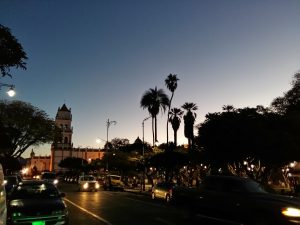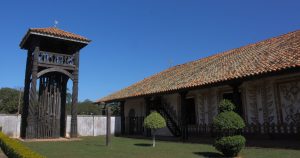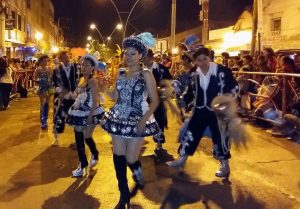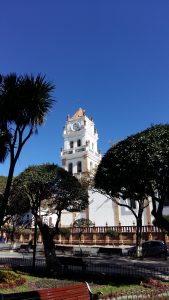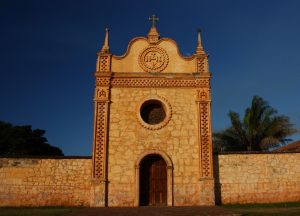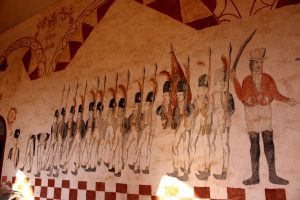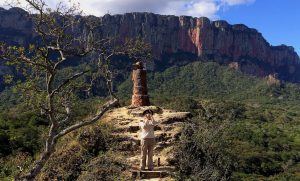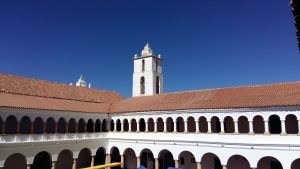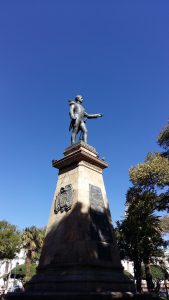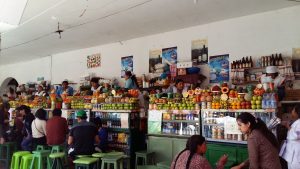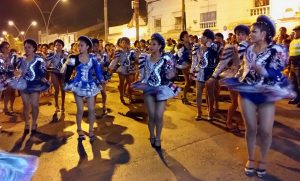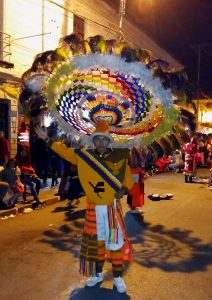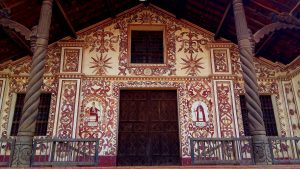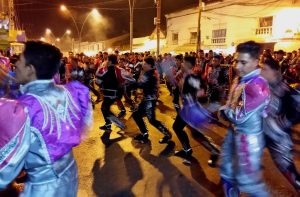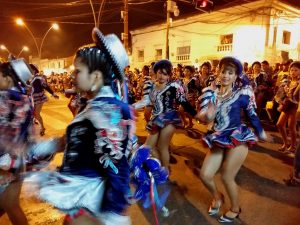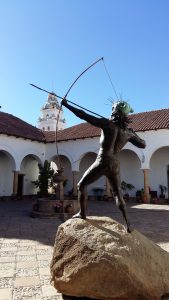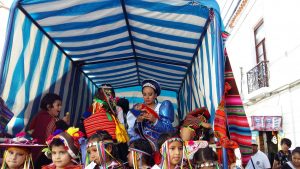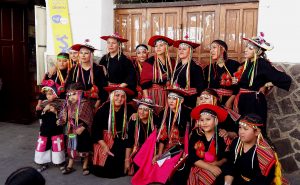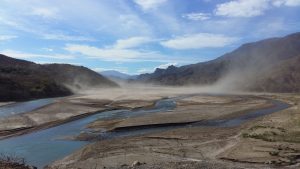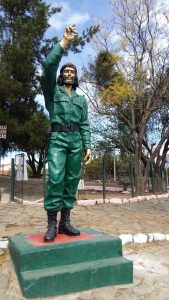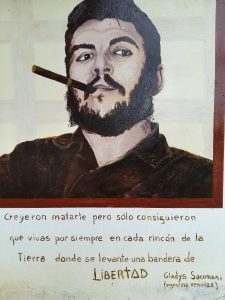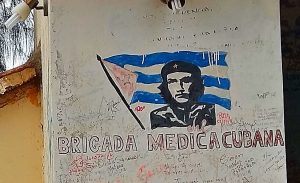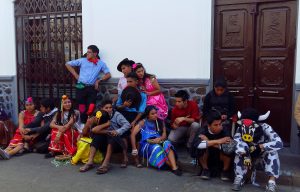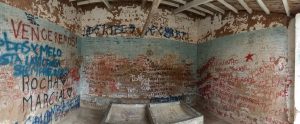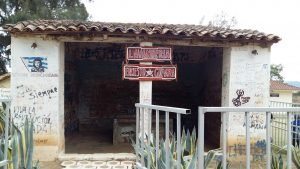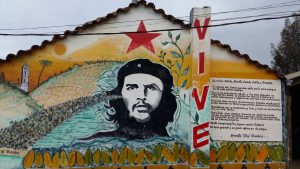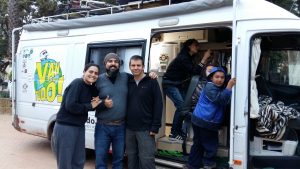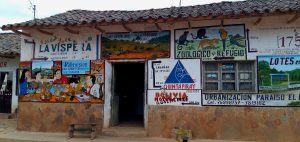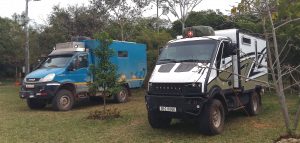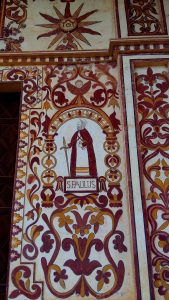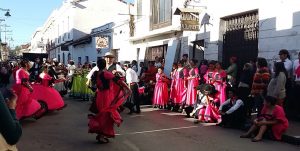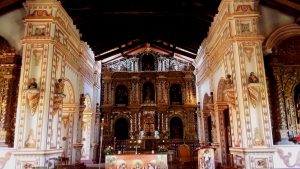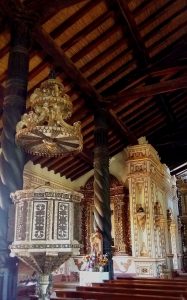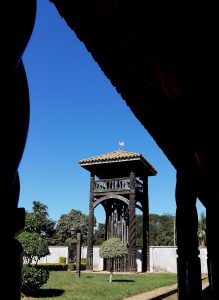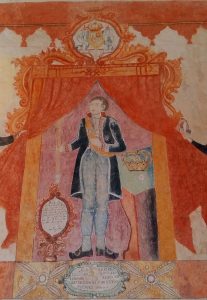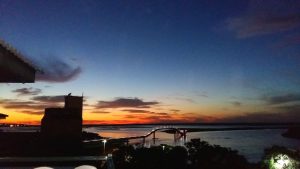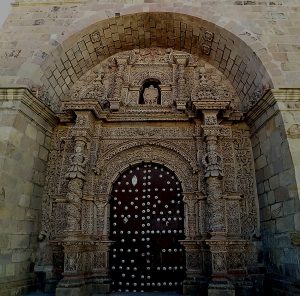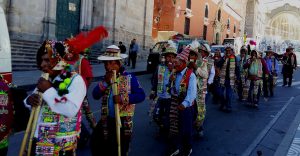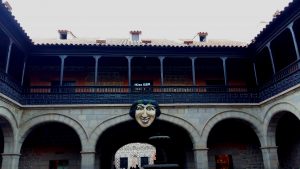Chiquitania is a land far from Bolivia’s stereotypical image of Andean high peaks, llamas and chunky chaps in brimmed hats and colourful ponchos. Here is Bolivia’s eastern flat, humid wetland punctuated by some scenic red-rock monoliths and some interesting sights. We’re back from Brazil and heading west through Chiquitania to the highlands, but on the way we have the small matter of recovering our deposited food store.
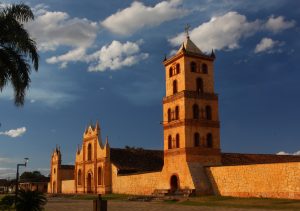
Food store
Hands-up, who remembers our food story before we went to Brazil? Problem was, we had a lot, lot of food and only realised at last minute that most of it wouldn’t be allowed into Brazil (this is apparently not a general problem entering Brazil, just this particular border having a current crack-down). So we deposited it all with a hotel in Bolivia before we crossed the border. Now, keep your hand up if you really believed that our food would still be there waiting for us weeks later when we returned from Brazil to collect it. Well, we had our doubts too, but we figured that if the food were to be distributed amongst the hotel staff in our absence, that would be preferable to it being confiscated by Brazilian customs officers.
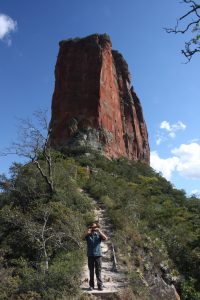 Doubts aside, we did have sufficient faith that we took a 30km detour to collect it. And guess what? It was there! Complete, in its bag, exactly where we had left it in the hotel store room. Hurrah!! Oh, we were so glad to see it. English tea-bags, breakfast cereals, marmite, honey, herbs and spices, and lots more. Yum. So nice to have our store-cupboard back again.
Doubts aside, we did have sufficient faith that we took a 30km detour to collect it. And guess what? It was there! Complete, in its bag, exactly where we had left it in the hotel store room. Hurrah!! Oh, we were so glad to see it. English tea-bags, breakfast cereals, marmite, honey, herbs and spices, and lots more. Yum. So nice to have our store-cupboard back again.
En-route to the food collection, we transited the eastern plain of Chiquitania. This is an underrated and under-visited area of Bolivia, but its remoteness does make it a tough destination to include on a jet-setter’s itinerary. In Aguas Calientes we swam in a lovely warm-springs river; in Santiago we hiked to some interesting rock formations; and in Chochis we visited a huge natural red-rock monolith with an interesting memorial to victims of a 1979 flood (built by the same Hans Roth of the Jesuit Missions restoration fame – this chap really knew how to take on a project!)
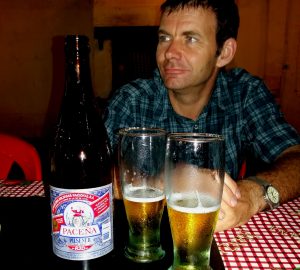 After all this and the rest of the Jesuit Missions, we retraced our previous route back towards central Bolivia. The city of Santa Cruz marks the end of the eastern lowlands, from here we climb back into the highlands and south to ‘La Ruta del Che’.
After all this and the rest of the Jesuit Missions, we retraced our previous route back towards central Bolivia. The city of Santa Cruz marks the end of the eastern lowlands, from here we climb back into the highlands and south to ‘La Ruta del Che’.
Sorry officer, I don’t smoke Spanish
On passing through Santa Cruz again, we are reminded of accounts from other travellers of some police corruption in the area. “Really?” you may enquire sarcastically with a single raised eyebrow, “Corrupt police officers in South America? You don’t say…!” 😉 Well okay, it’s not exactly incisive, investigative journalistic news, but mysteriously we seem to have avoided them so far.
Over one year driving around Africa and eight months in South America, we have countless times been stopped for ‘routine’ police checks. In some countries the stops came five or six time per day, but we have encountered only one (poorly concealed and slightly amusing) attempt at corruption (in Zimbabwe). In South America so far, even on routes well known amongst travellers for creative policing’ practices, it has never been even suggested to us that a financial contribution to the Police Tufty Club would be welcome or might expedite our journey.
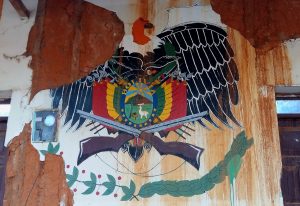 The last time we came through Santa Cruz on our way to Brazil, we passed various check-points but it was raining. The Santa Cruz copper apparently doesn’t like to get wet and we may have unwittingly benefitted from this. Unfortunately, this time the sun is shining and the chaps are out in force at the side of the highway. Our foreign registered, overland truck naturally increases the likelihood of a ‘random’ inspection.
The last time we came through Santa Cruz on our way to Brazil, we passed various check-points but it was raining. The Santa Cruz copper apparently doesn’t like to get wet and we may have unwittingly benefitted from this. Unfortunately, this time the sun is shining and the chaps are out in force at the side of the highway. Our foreign registered, overland truck naturally increases the likelihood of a ‘random’ inspection.
So… the officer waves his arm at you and as you pull over, the first question in your mind is ‘Should I speak Spanish?’ A much discussed topic about which Spanish speaking travellers often disagree, is whether to feign a lack of understanding the lingo.
Some say that chatting amicably to the officer with as much fluency as you can muster is likely to gain a friendly reception, a cursory inspection of documents and a cheerful wave goodbye. Others swear by the ‘Stupid-Stare’ tactic, hoping the officer will rapidly lose patience with the total inability to communicate and dismiss you in frustration. The ‘half-way house’ option is to make a disingenuously poor attempt at speaking the lingo. The latest suggestion from one over-lander (thanks Oliver!) is to try tactic this with humorous consequences; instead of “No hablo Español” (I don’t speak Spanish) try a poorly pronounced “No fumo Español” (I don’t smoke Spanish!). This tactic is aimed at getting a laugh from the officer, but it’s not a tried and tested method of police-relations… yet.
The decision of which tactic to deploy is probably best made at the time that you see the grin (or grimace) on the officer’s face as he stretches desperately to see into the high window of your overland truck. In Santa Cruz I decided each time to take a chance on the chatty option and… by luck or by judgment… it worked! Twice the chat resulted in us being waved on after a brief check of our documents. On the third occasion, the officer was friendly but claimed that we were missing a particular permit. “What’s that you say officer? A serious infraction? A fine?” A smile, a profuse apology and a few minutes of bulls**t sycophancy in my best Castellano Spanish allowed us to carry on without paying a jot. Ahhh, the occupational hazards of the overlanding lifestyle 🙂
La Ruta del Che
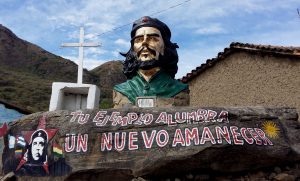 Police hassle and newly arrived rubbish weather, we’re not really sorry to leave Santa Cruz behind as we head west into the mountains to the small rural town of Valle Grande. Valle Grande’s claim to fame is the setting for the final days of an Argentinian chap, Ernesto Guevarra, yes that 1960s socialist revolutionary guy with the star beret, better known to his mates as ‘Che’.
Police hassle and newly arrived rubbish weather, we’re not really sorry to leave Santa Cruz behind as we head west into the mountains to the small rural town of Valle Grande. Valle Grande’s claim to fame is the setting for the final days of an Argentinian chap, Ernesto Guevarra, yes that 1960s socialist revolutionary guy with the star beret, better known to his mates as ‘Che’.
The ‘Ruta del Che’ (Che’s Route) socialist glory story was played down for many years in Bolivia but has been re-invigorated since the election of socialist Presidente Evo Morales who is no doubt a bit more sympathetic to Che’s philosophy. Years ago on a holiday to Cuba, we visited Che’s mausoleum and eternal flame in Santa Clara, so we were now interested to visit and learn about what happened here.
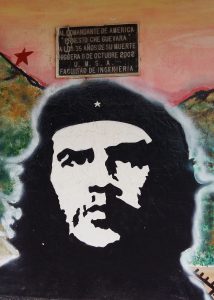 First, here’s the potted history bit: Che made his reputation as a hero of the 1959 Cuban revolution alongside Fidel Castro. He later came to Bolivia to plot other socialist revolutions across South America, but the CIA finally caught up with him and he was shot on 8th October 1967 in the nearby hamlet of La Higuera. His body was exhibited in Valle Grande (in the hospital laundry hut, of all places!) to prove to the world’s media that Commandante Che had indeed been captured and killed. An order then came for the local military to bury the body in a secret location and this remained secret until in 1997, the remains were found and exhumed. Che’s remains were repatriated to Cuba and the no-longer-secret burial site became a memorial shrine to his name.
First, here’s the potted history bit: Che made his reputation as a hero of the 1959 Cuban revolution alongside Fidel Castro. He later came to Bolivia to plot other socialist revolutions across South America, but the CIA finally caught up with him and he was shot on 8th October 1967 in the nearby hamlet of La Higuera. His body was exhibited in Valle Grande (in the hospital laundry hut, of all places!) to prove to the world’s media that Commandante Che had indeed been captured and killed. An order then came for the local military to bury the body in a secret location and this remained secret until in 1997, the remains were found and exhumed. Che’s remains were repatriated to Cuba and the no-longer-secret burial site became a memorial shrine to his name.
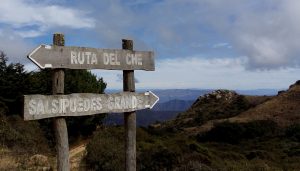 Monuments of varying degrees of tastefulness have been erected at the site of his shooting in La Higuera, but our guide took us on a very interesting (if slightly gruesome) short tour in Valle Grande to the hospital site where his body had been displayed, and to the memorial museum at the secret burial site. Clearly more resources are now being allocated to developing the site for tourism and the town is gearing up for the 50th Anniversary of his death next year. So if you want a ‘Che-Fest’ of mega proportions, head to Valle Grande for 8th October 2017.
Monuments of varying degrees of tastefulness have been erected at the site of his shooting in La Higuera, but our guide took us on a very interesting (if slightly gruesome) short tour in Valle Grande to the hospital site where his body had been displayed, and to the memorial museum at the secret burial site. Clearly more resources are now being allocated to developing the site for tourism and the town is gearing up for the 50th Anniversary of his death next year. So if you want a ‘Che-Fest’ of mega proportions, head to Valle Grande for 8th October 2017.
Sucre – ‘Party town’
We chose the slow-road across central Bolivia and it takes us a scenic 2 days to do a drive that would otherwise take a few hours on the main roads. Eventually we arrived in the country’s constitutional capital city, Sucre. And what a fab city!
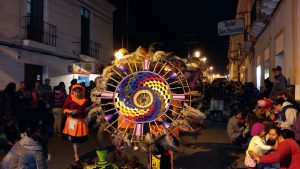 Chaos reigned as we arrived to find city streets closed for fiestas; this lovely colonial city was taken over by colourful parades of folksy and carnaval-style dancers. They continued well into the night with a buzzing atmosphere as locals crammed onto the pavements of the narrow streets to cheer the spectacle. The brass bands were occasionally slightly less than tuneful, but their lively beat was a fantastic accompaniment to troupes of energetic dancers, all trying to out-glitter each other in their multi-sparkle outfits. Fabulous!
Chaos reigned as we arrived to find city streets closed for fiestas; this lovely colonial city was taken over by colourful parades of folksy and carnaval-style dancers. They continued well into the night with a buzzing atmosphere as locals crammed onto the pavements of the narrow streets to cheer the spectacle. The brass bands were occasionally slightly less than tuneful, but their lively beat was a fantastic accompaniment to troupes of energetic dancers, all trying to out-glitter each other in their multi-sparkle outfits. Fabulous!
O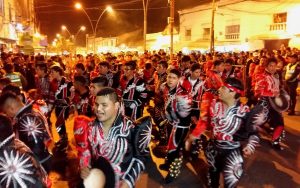 ur initial impression of Sucre was no doubt heavily influenced by this fiesta of music and dance, but over the next few days we got to know the quieter side of this beautiful city. As a UNESCO World Heritage site it has restricted development to preserver it’s charming colonial atmosphere. The main plaza has the grand civic and religious buildings, but there are also many streets of well-preserved facades. Sucre is understandably a little touristy, but it still retains an authentic feel as a bustling Bolivian university town with tasty local street food as well as great cafes and restaurants.
ur initial impression of Sucre was no doubt heavily influenced by this fiesta of music and dance, but over the next few days we got to know the quieter side of this beautiful city. As a UNESCO World Heritage site it has restricted development to preserver it’s charming colonial atmosphere. The main plaza has the grand civic and religious buildings, but there are also many streets of well-preserved facades. Sucre is understandably a little touristy, but it still retains an authentic feel as a bustling Bolivian university town with tasty local street food as well as great cafes and restaurants.
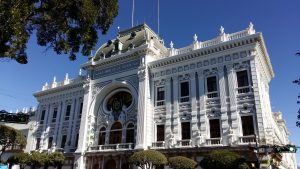 Sucre is not only one of the top destinations for tourism in Bolivia today, it was also a top meeting place for dinosaurs millions of years ago. Literally thousands of dinosaur footprints have been unearthed creating an educational paleontological attraction.
Sucre is not only one of the top destinations for tourism in Bolivia today, it was also a top meeting place for dinosaurs millions of years ago. Literally thousands of dinosaur footprints have been unearthed creating an educational paleontological attraction.
Potosí – ‘Dosh town’
You may have gathered that we rather liked Sucre, but just a few hours’ drive away is another colonial treasure, Potosí. At over 4,000m (over 13,000ft) it is the highest city of its size in the world, and you certainly feel the thin air here!
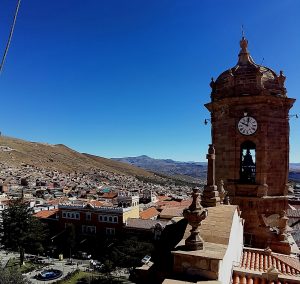 The city is famous for having been the original centre for the production of silver and coins for the Spanish empire. The National Mint museum is a beautifully presented account of the silver industry and the history of currency manufacture. Did you know that Potosi supplied the early currency to the newly formed United States of America and the symbol of the US dollar $ originated here? The whole city is full of history and culture, and also some very narrow streets! We had a challenge navigating Cuthbert around the one-way system, but it was really worth the stress to spend a bit of time here.
The city is famous for having been the original centre for the production of silver and coins for the Spanish empire. The National Mint museum is a beautifully presented account of the silver industry and the history of currency manufacture. Did you know that Potosi supplied the early currency to the newly formed United States of America and the symbol of the US dollar $ originated here? The whole city is full of history and culture, and also some very narrow streets! We had a challenge navigating Cuthbert around the one-way system, but it was really worth the stress to spend a bit of time here.
If there is one small ‘snagette’ to spending time in Potosi, it is the vehicle pollution. Vehicle emission standards across Bolivia are obviously not exactly ‘Euro 5’, but up here at 4,000m the vehicles struggle more than ever. Drivers rev and rev the engines to gain power for the hills, belching noxious clouds of black smoke into the narrow streets. Not ideal, but not a deal-breaker for tourism… yet.
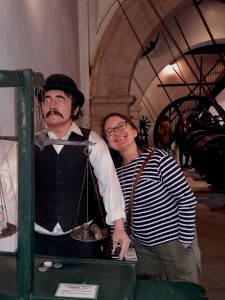 In the league of South American colonial treasures, Sucre and Potosi are often mentioned in the same sentence as Argentina’s (so called) equivalent destination, Salta. Frankly, we don’t think there is any contest here – Sucre and Potosí win hands down by most measures of comparison. These have been two of our favourite cities on this whole trip so far and Bolivia should be rightly proud of them as show-case tourism destinations.
In the league of South American colonial treasures, Sucre and Potosi are often mentioned in the same sentence as Argentina’s (so called) equivalent destination, Salta. Frankly, we don’t think there is any contest here – Sucre and Potosí win hands down by most measures of comparison. These have been two of our favourite cities on this whole trip so far and Bolivia should be rightly proud of them as show-case tourism destinations.
So we move on again… story to follow soon of Uyuni Salt Pans, hopefully staying on top of the crust 🙂
Link to next blog: Altiplano and whiteness Link to full South America Blog
Back to Bolivia Gallery
- Jesuit Missions Bolivia

